

Compact Muon Solenoid
LHC, CERN
| CMS-PAS-EXO-17-029 | ||
| Search for singly produced third-generation leptoquarks decaying to a $\tau$ lepton and a b quark in proton-proton collisions at $\sqrt{s}= $ 13 TeV | ||
| CMS Collaboration | ||
| March 2018 | ||
| Abstract: A search is presented for singly produced third-generation scalar leptoquarks decaying to a $\tau$ lepton and a b quark. Events containing two $\tau$ leptons and one jet originating from a b quark are considered. The search is based on proton-proton collision data at a center-of-mass energy of 13 TeV recorded with the CMS detector and corresponding to an integrated luminosity of 35.9 fb$^{-1}$. Upper limits are set on the third-generation scalar leptoquark production cross section as a function of the leptoquark mass. Results are compared with theoretical predictions to obtain lower limits on the leptoquark mass. At 95% confidence level, third-generation scalar leptoquarks decaying to a $\tau$ lepton and a b quark with unit coupling are excluded for masses below 744 GeV. Limits are also set on the couplings of such leptoquarks as a function of their mass. | ||
|
Links:
CDS record (PDF) ;
inSPIRE record ;
CADI line (restricted) ;
These preliminary results are superseded in this paper, JHEP 07 (2018) 115. The superseded preliminary plots can be found here. |
||
| Figures | |

png pdf |
Figure 1:
Feynman diagrams of singly produced third-generation LQs decaying to a $\tau $ lepton and a b quark. |
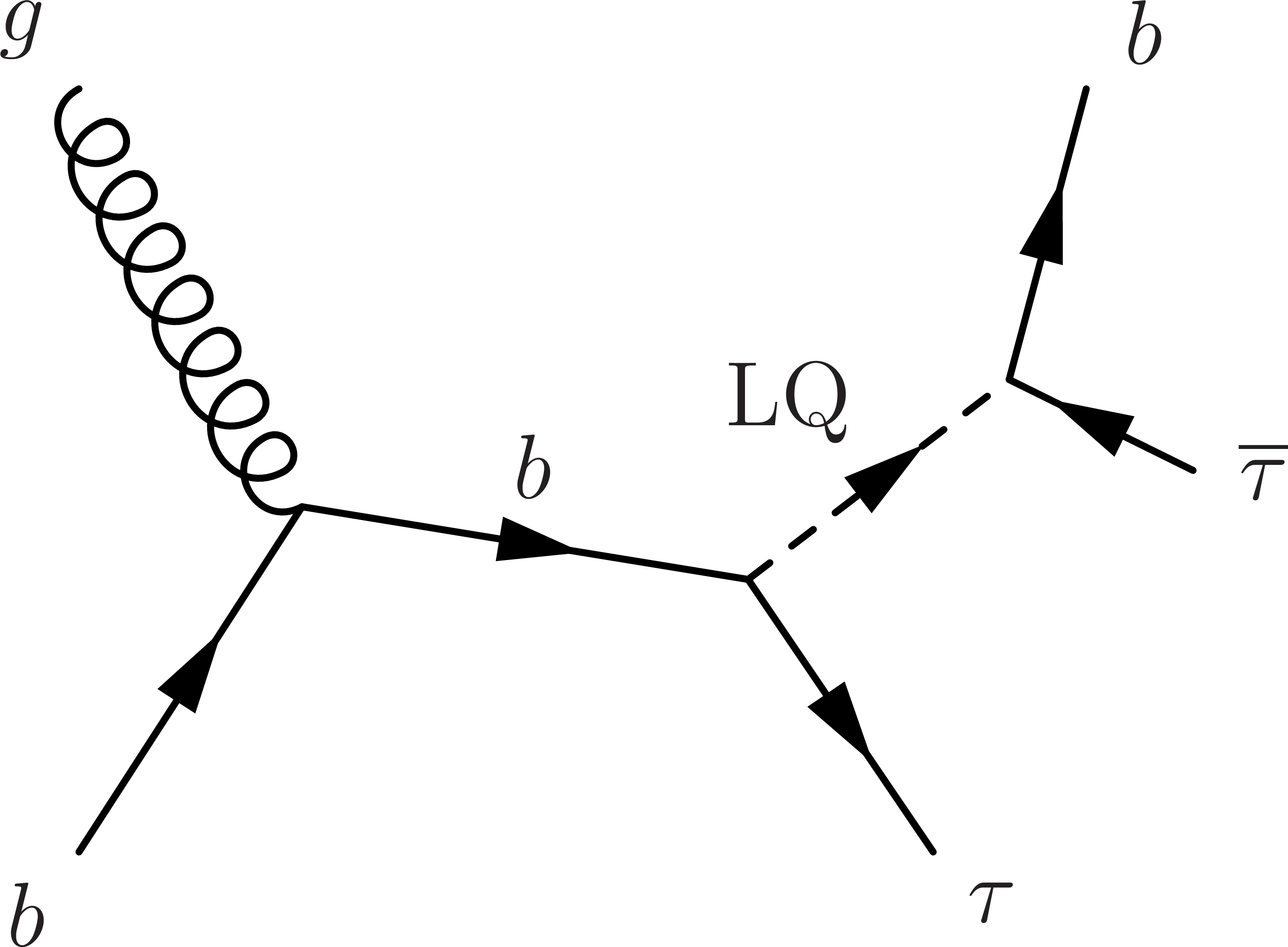
png pdf |
Figure 1-a:
Feynman diagrams of singly produced third-generation LQs decaying to a $\tau $ lepton and a b quark. |
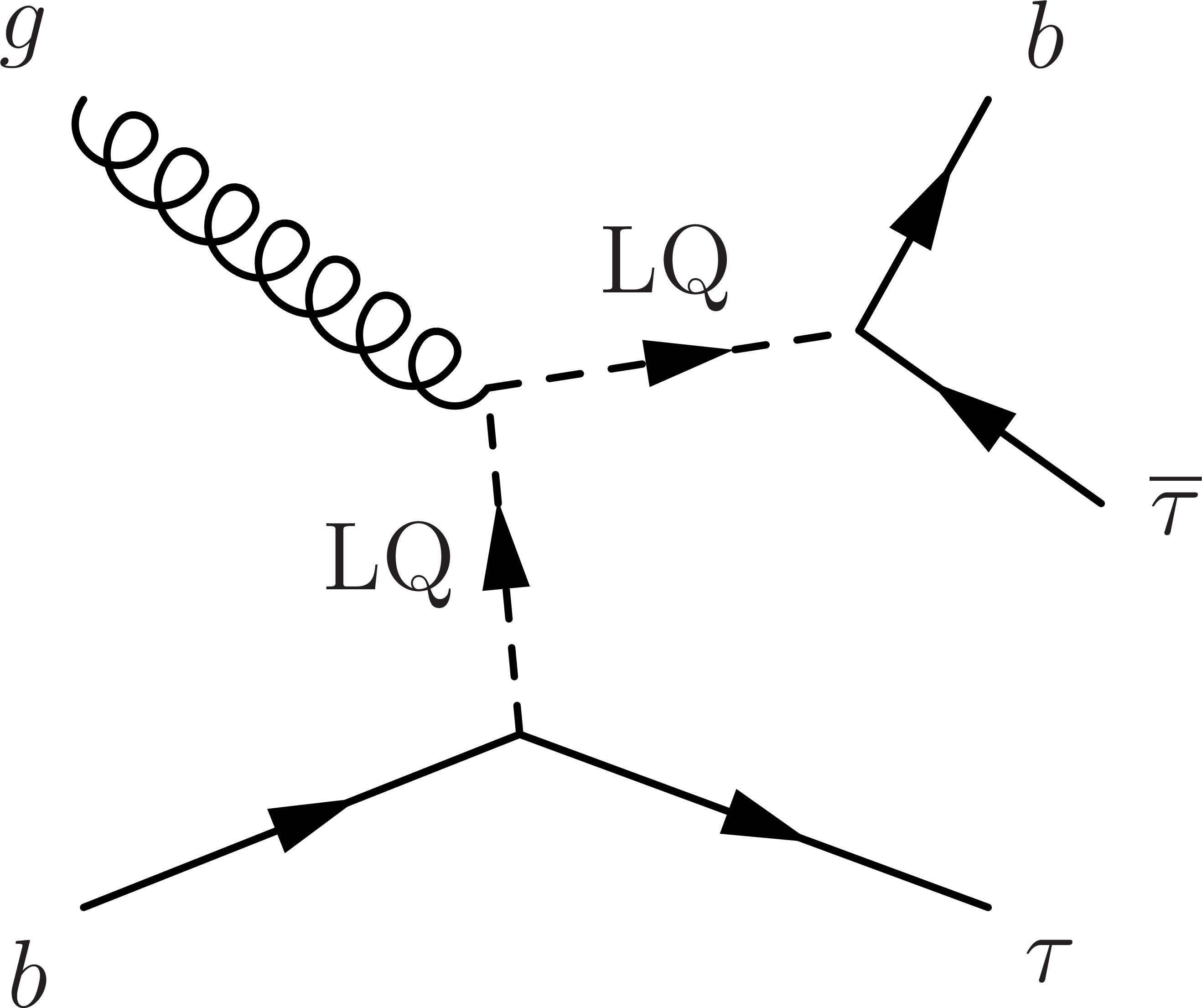
png pdf |
Figure 1-b:
Feynman diagrams of singly produced third-generation LQs decaying to a $\tau $ lepton and a b quark. |
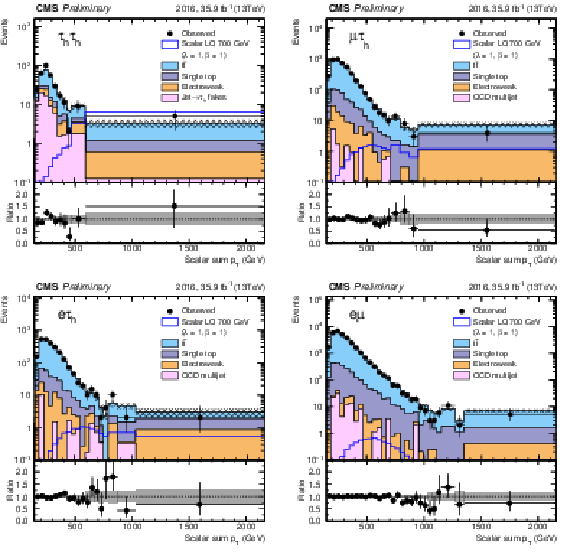
png pdf |
Figure 2:
Measured $S_\text {T}$ distribution in $ {{\tau}_{\rm h}} {{\tau}_{\rm h}} $ (top-left), $ {{\mu}} {{\tau}_{\rm h}} $ (top-right), $ {\mathrm {e}} {{\tau}_{\rm h}} $ (bottom-left) and $ {\mathrm {e}} {{\mu}}$ (bottom-right) channels, compared to expected Standard Model background contributions. The distribution called Electroweak contains the contributions from $ {\mathrm {W}}+ \text {jets}$, $ {\mathrm {Z}} + \text {jets}$, and diboson processes. The signal distributions for the single LQ production with mass 700 GeV are overlaid to illustrate the sensitivity. For the signal normalization, $\lambda = $ 1 and $\beta = $ 1 are assumed. The uncertainty bands represent the sum in quadrature of statistical and systematic uncertainties obtained from the fit. The lower panels in all plots compare the observed and expected events in each bin. |
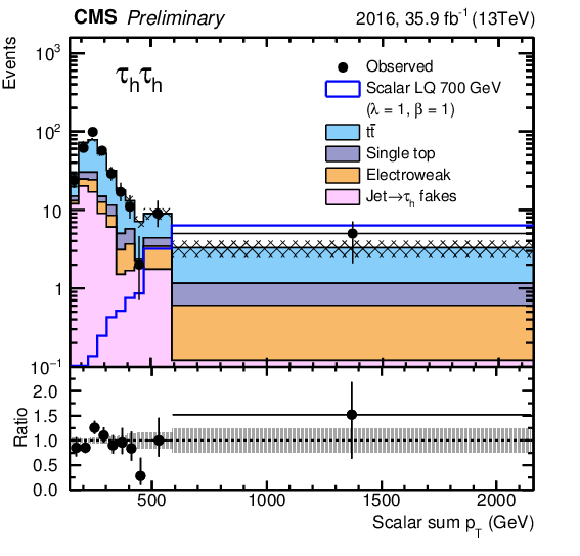
png pdf |
Figure 2-a:
Measured $S_\text {T}$ distribution in $ {{\tau}_{\rm h}} {{\tau}_{\rm h}} $ (top-left), $ {{\mu}} {{\tau}_{\rm h}} $ (top-right), $ {\mathrm {e}} {{\tau}_{\rm h}} $ (bottom-left) and $ {\mathrm {e}} {{\mu}}$ (bottom-right) channels, compared to expected Standard Model background contributions. The distribution called Electroweak contains the contributions from $ {\mathrm {W}}+ \text {jets}$, $ {\mathrm {Z}} + \text {jets}$, and diboson processes. The signal distributions for the single LQ production with mass 700 GeV are overlaid to illustrate the sensitivity. For the signal normalization, $\lambda = $ 1 and $\beta = $ 1 are assumed. The uncertainty bands represent the sum in quadrature of statistical and systematic uncertainties obtained from the fit. The lower panels in all plots compare the observed and expected events in each bin. |

png pdf |
Figure 2-b:
Measured $S_\text {T}$ distribution in $ {{\tau}_{\rm h}} {{\tau}_{\rm h}} $ (top-left), $ {{\mu}} {{\tau}_{\rm h}} $ (top-right), $ {\mathrm {e}} {{\tau}_{\rm h}} $ (bottom-left) and $ {\mathrm {e}} {{\mu}}$ (bottom-right) channels, compared to expected Standard Model background contributions. The distribution called Electroweak contains the contributions from $ {\mathrm {W}}+ \text {jets}$, $ {\mathrm {Z}} + \text {jets}$, and diboson processes. The signal distributions for the single LQ production with mass 700 GeV are overlaid to illustrate the sensitivity. For the signal normalization, $\lambda = $ 1 and $\beta = $ 1 are assumed. The uncertainty bands represent the sum in quadrature of statistical and systematic uncertainties obtained from the fit. The lower panels in all plots compare the observed and expected events in each bin. |
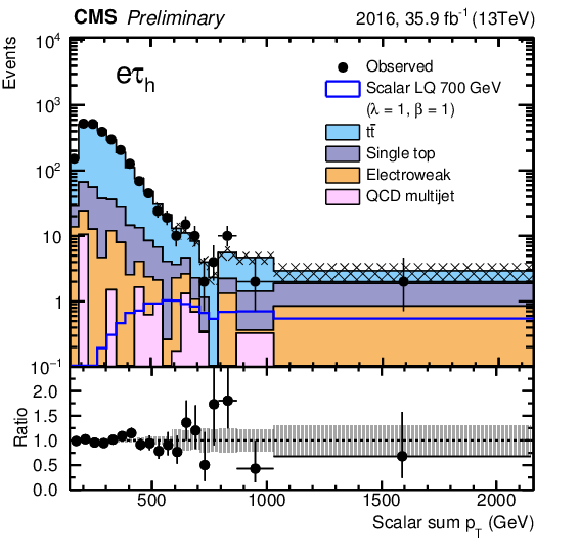
png pdf |
Figure 2-c:
Measured $S_\text {T}$ distribution in $ {{\tau}_{\rm h}} {{\tau}_{\rm h}} $ (top-left), $ {{\mu}} {{\tau}_{\rm h}} $ (top-right), $ {\mathrm {e}} {{\tau}_{\rm h}} $ (bottom-left) and $ {\mathrm {e}} {{\mu}}$ (bottom-right) channels, compared to expected Standard Model background contributions. The distribution called Electroweak contains the contributions from $ {\mathrm {W}}+ \text {jets}$, $ {\mathrm {Z}} + \text {jets}$, and diboson processes. The signal distributions for the single LQ production with mass 700 GeV are overlaid to illustrate the sensitivity. For the signal normalization, $\lambda = $ 1 and $\beta = $ 1 are assumed. The uncertainty bands represent the sum in quadrature of statistical and systematic uncertainties obtained from the fit. The lower panels in all plots compare the observed and expected events in each bin. |
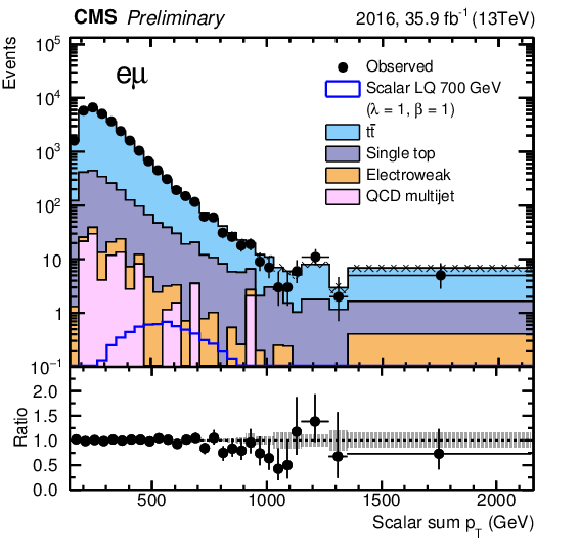
png pdf |
Figure 2-d:
Measured $S_\text {T}$ distribution in $ {{\tau}_{\rm h}} {{\tau}_{\rm h}} $ (top-left), $ {{\mu}} {{\tau}_{\rm h}} $ (top-right), $ {\mathrm {e}} {{\tau}_{\rm h}} $ (bottom-left) and $ {\mathrm {e}} {{\mu}}$ (bottom-right) channels, compared to expected Standard Model background contributions. The distribution called Electroweak contains the contributions from $ {\mathrm {W}}+ \text {jets}$, $ {\mathrm {Z}} + \text {jets}$, and diboson processes. The signal distributions for the single LQ production with mass 700 GeV are overlaid to illustrate the sensitivity. For the signal normalization, $\lambda = $ 1 and $\beta = $ 1 are assumed. The uncertainty bands represent the sum in quadrature of statistical and systematic uncertainties obtained from the fit. The lower panels in all plots compare the observed and expected events in each bin. |
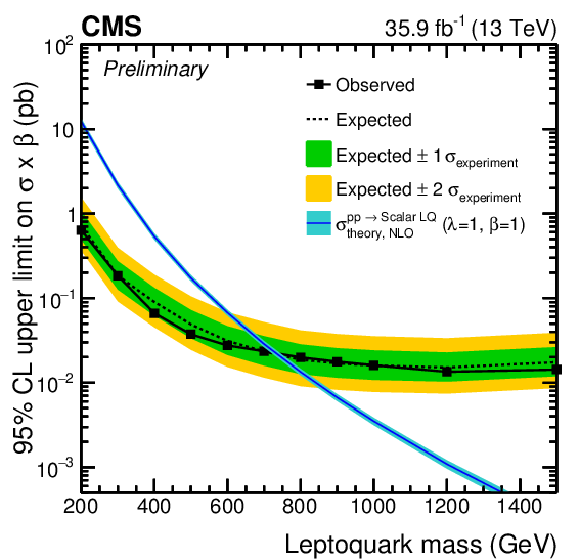
png pdf |
Figure 3:
Observed and expected limits at 95% confidence level (CL) on the product of cross section and branching fraction, obtained from the combination of the $ {\mathrm {e}} {{\tau}_{\rm h}} $, $ {{\mu}} {{\tau}_{\rm h}} $ and $ {{\tau}_{\rm h}} {{\tau}_{\rm h}} $ channels. The green and yellow bands represent the one and two standard deviation uncertainties in the expected limits. |
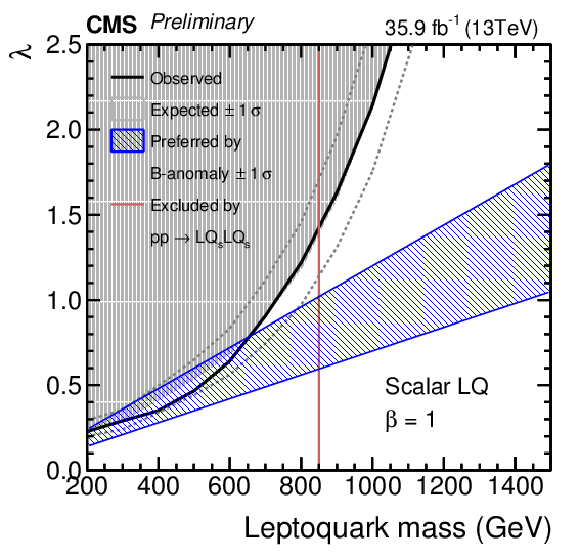
png pdf |
Figure 4:
The 95% confidence level expected and observed exclusion limits on the Yukawa coupling $\lambda $ at the LQ-lepton-quark vertex, as a function of the LQ mass. A branching fraction of the LQ to a $\tau $ lepton and a b quark $\beta = $ 1 is assumed. The red line corresponds to the limit obtained from a search for pair-produced LQs decaying to $\ell \tau _\text {h}\mathrm{bb} $ [24]. The vertically shaded region is the expected exclusion limit from this analysis. The diagonally shaded blue region shows the parameter space preferred by the anomalies reported by B-factory experiments [23]. |

png pdf |
Figure 5:
The acceptance for the singly produced LQ signals in $ {{\tau}_{\rm h}} {{\tau}_{\rm h}} $ (black), $ {{\mu}} {{\tau}_{\rm h}} $ (red), and $ {\mathrm {e}} {{\tau}_{\rm h}} $ (blue) channels, as a function of the leptoquark mass. The acceptance includes the branching fraction of $\tau \tau \to {{\tau}_{\rm h}} {{\tau}_{\rm h}} $ (42%), $\tau \tau \to {{\mu}} {{\tau}_{\rm h}} $ (21%), and $\tau \tau \to {\mathrm {e}} {{\tau}_{\rm h}} $ (21%). |
| Tables | |
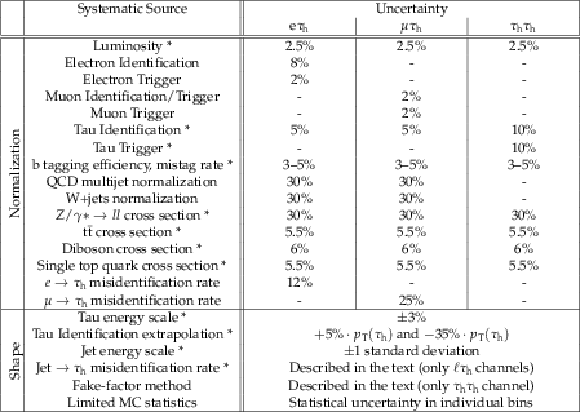
png pdf |
Table 1:
List of systematic uncertainties considered in this analysis. Those uncertainties marked with a * are treated as correlated among channels. |

png pdf |
Table 2:
Number of events observed in the $ {\mathrm {e}} {{\tau}_{\rm h}} $, $ {{\mu}} {{\tau}_{\rm h}} $, and $ {{\tau}_{\rm h}} {{\tau}_{\rm h}} $ channels for $S_\text {T} > $ 500 GeV, compared to the background expectations and to the event yield expected for single LQ processes with LQ mass 700 GeV ($\lambda = $ 1 and $\beta = $ 1). "Electroweak'' contains the contributions from $ {\mathrm {W}}+ \text {jets}$, $ {\mathrm {Z}} + \text {jets}$, and diboson processes. The uncertainties represent the sum in quadrature of statistical and systematic uncertainties and are obtained by the binned maximum likelihood fit of the $S_\text {T}$ distribution. |
| Summary |
| A search has been made for singly produced third-generation scalar leptoquarks decaying to a $\tau$ lepton and a b quark. The final states of an electron or muon plus one hadronically-decaying $\tau$ lepton or two hadronically-decaying $\tau$ leptons are explored. In both final states at least one energetic jet originating from a b quark is required. The search is based on a data sample of proton-proton collisions at a center-of-mass energy of 13 TeV recorded with the CMS detector and corresponding to an integrated luminosity of 35.9 fb$^{-1}$. The data are found to be in good agreement with the standard model prediction and upper limits are set on the third-generation scalar leptoquark production cross section as a function of the leptoquark mass. Results are compared with theoretical predictions to obtain lower limits on the leptoquark mass. Assuming the leptoquark always decays to a $\tau$ lepton and a b quark, third-generation scalar leptoquarks with masses below 744 GeV are excluded at 95% confidence level. A limit is also placed on the Yukawa coupling at the LQ-$\tau$-b vertex, allowing for leptoquark masses up to 1052 GeV to be excluded for large Yukawa couplings of $\lambda > $ 2.5. This is the first result showing the limit in this parameter space plane, and with respect to the preferred region reported by B-factory experiments. |
| References | ||||
| 1 | H. Georgi and S. L. Glashow | Unity of all elementary-particle forces | PRL 32 (Feb, 1974) 438--441 | |
| 2 | J. C. Pati and A. Salam | Unified lepton-hadron symmetry and a gauge theory of the basic interactions | PRD 8 (Aug, 1973) 1240--1251 | |
| 3 | J. C. Pati and A. Salam | Lepton number as the fourth "color" | PRD 10 (Jul, 1974) 275--289 | |
| 4 | H. Murayama and T. Yanagida | A viable SU(5) GUT with light leptoquark bosons | MPLA7 (1992) 147--152 | |
| 5 | H. Fritzsch and P. Minkowski | Unified Interactions of Leptons and Hadrons | Annals Phys. 93 (1975) 193--266 | |
| 6 | G. Senjanovic and A. Sokorac | Light Leptoquarks in SO(10) | Z. Phys. C20 (1983) 255 | |
| 7 | P. H. Frampton and B. H. Lee | SU (15) Grand Unification | PRL 65 (Oct, 1990) 2209--2209 | |
| 8 | P. H. Frampton and T. W. Kephart | Higgs sector and proton decay in SU(15) grand unification | PRD 42 (Dec, 1990) 3892--3894 | |
| 9 | S. Dimopoulos and L. Susskind | Mass without scalars | Nuclear Physics B 155 (1979), no. 1, 237 -- 252 | |
| 10 | S. Dimopoulos | Technicoloured signatures | Nuclear Physics B 168 (1980), no. 1, 69 -- 92 | |
| 11 | E. Farhi and L. Susskind | Technicolour | Physics Reports 74 (1981), no. 3, 277 -- 321 | |
| 12 | B. Schrempp and F. Schrempp | Light leptoquarks | Physics Letters B 153 (1985), no. 1, 101 -- 107 | |
| 13 | W. Buchmüller and D. Wyler | Constraints on SU(5)-type leptoquarks | Physics Letters B 177 (1986), no. 3, 377 -- 382 | |
| 14 | O. Shanker | $ \pi\ell $2, K$ \ell $3, and K$ ^0 $-$ \bar{\text{K}}^0 $ constraints on leptoquarks and supersymmetric particles | Nuclear Physics B 204 (1982), no. 3, 375 -- 386 | |
| 15 | LHCb Collaboration | Differential branching fractions and isospin asymmetries of $ B \to K^{(*)}\mu^{+}\mu^{-} $ decays | Journal of High Energy Physics 2014 (Jun, 2014) 133 | |
| 16 | LHCb Collaboration | Measurements of the S-wave fraction in $ B^0\to K^{*}(892)^{0}\mu^{+}\mu^{0} $ differential branching fraction | Journal of High Energy Physics 2016 (Nov, 2016) | |
| 17 | LHCb Collaboration | Angular analysis and differential branching fraction of the decay $ B_s^{0}\to\phi \mu^{+}\mu^{-} $ | Journal of High Energy Physics 2015 (Sep, 2015) 179 | |
| 18 | LHCb Collaboration | Angular analysis of the $ B_s^{0}\to\phi K^{*0}\mu^{+}\mu^{-} $ decay using 3~fb$ ^{-1} $ of integrated luminosity | Journal of High Energy Physics 2016 (Feb, 2016) 104 | |
| 19 | Belle Collaboration | Lepton-Flavor-Dependent Angular Analysis of $ B {\rightarrow}{K}^{*}{{\ell}}^{+}{{\ell}}^{{-}} $ | PRL 118 (Mar, 2017) 111801 | |
| 20 | BABAR Collaboration | Measurement of an excess of $ \overline{B} {\rightarrow}{D}^{\mathbf{(}*\mathbf{)}}{{\tau}}^{\mathbf{{-}}}{\overline{{\nu}}}_{{\tau}} $ decays and implications for charged Higgs bosons | PRD 88 (Oct, 2013) 072012 | |
| 21 | Belle Collaboration | Measurement of the $ {\tau} $ lepton polarization and $ {R({D}^{*})} $ in the decay $ \overline{B} {\rightarrow}{D}^{*}{{\tau}}^{{-}}{\overline{{\nu}}}_{{\tau}} $ | PRL 118 (May, 2017) 211801 | |
| 22 | LHCb Collaboration | Measurement of the Ratio of Branching Fractions $ \mathcal{B}({\overline{B}}^{0} {\rightarrow}{D}^{*+}{{\tau}}^{{-}}{\overline{{\nu}}}_{{\tau}})/\mathcal{B}({\overline{B}}^{0} {\rightarrow}{D}^{*+}{{\mu}}^{{-}}{\overline{{\nu}}}_{{\mu}}) $ | PRL 115 (Sep, 2015) 111803 | |
| 23 | D. Buttazzo, A. Greljo, G. Isidori, and D. Marzocca | B-physics anomalies: a guide to combined explanations | JHEP 11 (2017) 044 | 1706.07808 |
| 24 | CMS Collaboration | Search for third-generation scalar leptoquarks and heavy right-handed neutrinos in final states with two tau leptons and two jets in proton-proton collisions at $ \sqrt{s}= $ 13 TeV | CDS | |
| 25 | CMS Collaboration | Search for third generation scalar leptoquarks decaying to a top quark and a tau lepton at sqrt(s) = 13 TeV | CMS-PAS-B2G-16-028 | CMS-PAS-B2G-16-028 |
| 26 | CMS Collaboration | The CMS trigger system | CMS-TRG-12-001 1609.02366 |
|
| 27 | CMS Collaboration | The CMS experiment at the CERN LHC | JINST 3 (2008) S08004 | CMS-00-001 |
| 28 | J. Alwall et al. | The automated computation of tree-level and next-to-leading order differential cross sections, and their matching to parton shower simulations | JHEP 07 (2014) 079 | 1405.0301 |
| 29 | I. Doršner et al. | Physics of leptoquarks in precision experiments and at particle colliders | PR 641 (2016) 1--68 | 1603.04993 |
| 30 | I. Doršner and A. Greljo | Leptoquark toolbox for precision collider studies | 1801.07641 | |
| 31 | R. D. Ball et al. | Unbiased global determination of parton distributions and their uncertainties at NNLO and at LO | NPB 855 (2012) 153 | 1107.2652 |
| 32 | J. Alwall et al. | Comparative study of various algorithms for the merging of parton showers and matrix elements in hadronic collisions | EPJC 53 (2008) 473 | 0706.2569 |
| 33 | R. Frederix and S. Frixione | Merging meets matching in MC@NLO | JHEP 12 (2012) 061 | 1209.6215 |
| 34 | T. Sjostrand et al. | An introduction to PYTHIA 8.2 | CPC 191 (2015) 159 | 1410.3012 |
| 35 | CMS Collaboration | Event generator tunes obtained from underlying event and multiparton scattering measurements | EPJC 76 (2016), no. 3, 155 | CMS-GEN-14-001 1512.00815 |
| 36 | GEANT4 Collaboration | GEANT4 --- a simulation toolkit | NIMA 506 (2003) 250 | |
| 37 | CMS Collaboration | Particle-flow reconstruction and global event description with the CMS detector | JINST 12 (2017), no. 10, P10003 | CMS-PRF-14-001 1706.04965 |
| 38 | CMS Collaboration | Performance of CMS muon reconstruction in pp collision events at $ \sqrt{s}= $ 7 TeV | JINST 7 (2012) P10002 | CMS-MUO-10-004 1206.4071 |
| 39 | CMS Collaboration | Electron reconstruction and identification at $ \sqrt{s} = $ 7 TeV | CMS-PAS-EGM-10-004 | |
| 40 | M. Cacciari, G. P. Salam, and G. Soyez | FastJet user manual | EPJC 72 (2012) 1896 | 1111.6097 |
| 41 | M. Cacciari and G. P. Salam | Dispelling the $ N^{3} $ myth for the $ k_t $ jet-finder | PLB 641 (2006) 57 | hep-ph/0512210 |
| 42 | CMS Collaboration | Determination of jet energy calibration and transverse momentum resolution in CMS | JINST 6 (2011) 11002 | CMS-JME-10-011 1107.4277 |
| 43 | CMS Collaboration | Identification of heavy-flavour jets with the CMS detector in pp collisions at 13 TeV | Submitted to \it JINST | CMS-BTV-16-002 1712.07158 |
| 44 | CMS Collaboration | Reconstruction and identification of $ \tau $ lepton decays to hadrons and $ \nu_\tau $ at CMS | JINST 11 (2016) P01019 | CMS-TAU-14-001 1510.07488 |
| 45 | CMS Collaboration | Performance of reconstruction and identification of tau leptons in their decays to hadrons and tau neutrino in LHC Run-2 | CMS-PAS-TAU-16-002 | CMS-PAS-TAU-16-002 |
| 46 | H. Voss, A. Hocker, J. Stelzer, and F. Tegenfeldt | TMVA, the Toolkit for Multivariate Data Analysis with ROOT | in XI Int. Workshop on Advanced Computing and Analysis Techniques in Physics Research 2007 PoS ACAT:040 | physics/0703039 |
| 47 | CMS Collaboration | Performance of missing transverse momentum reconstruction algorithms in proton-proton collisions at $ \sqrt{s}= $ 8 TeV with the CMS detector | CMS-PAS-JME-12-002 | CMS-PAS-JME-12-002 |
| 48 | CMS Collaboration | Search for additional neutral MSSM Higgs bosons in the di-tau final state in $ pp $ collisions at $ \sqrt{s}= $ 13 TeV | CMS-PAS-HIG-17-020 | CMS-PAS-HIG-17-020 |
| 49 | CMS Collaboration | Measurement of the $ \mathrm{Z}\gamma^{*} \to \tau\tau $ cross section in pp collisions at $ \sqrt{s} = $ 13 TeV and validation of $ \tau $ lepton analysis techniques | CMS-HIG-15-007 1801.03535 |
|
| 50 | G. Cowan, K. Cranmer, E. Gross, and O. Vitells | Asymptotic formulae for likelihood-based tests of new physics | The European Physical Journal C 71 (Feb, 2011) | 1007.1727 |
| 51 | ATLAS Collaboration | Procedure for the LHC Higgs boson search combination in summer 2011 | ATL-PHYS-PUB-2011-011, CERN, Aug | |
| 52 | CMS Collaboration | CMS luminosity measurements for the 2016 data taking period | CMS-PAS-LUM-17-001 | CMS-PAS-LUM-17-001 |
| 53 | CMS Collaboration | Measurement of the inclusive W and Z production cross sections in pp collisions at $ \sqrt{s} = $ 7 TeV with the CMS experiment | JHEP 10 (2011) 132 | CMS-EWK-10-005 1107.4789 |
| 54 | CMS Collaboration | Performance of tau-lepton reconstruction and identification in CMS | JINST 7 (2012) P01001 | CMS-TAU-11-001 1109.6034 |
| 55 | A. L. Read | Presentation of search results: the CLs technique | Journal of Physics G: Nuclear and Particle Physics 28 (2002), no. 10 | |
| 56 | T. Junk | Confidence level computation for combining searches with small statistics | Nuclear Instruments and Methods in Physics Research Section A: Accelerators, Spectrometers, Detectors and Associated Equipment 434 (1999), no. 2, 435 -- 443 | |

|
Compact Muon Solenoid LHC, CERN |

|

|

|

|

|

|